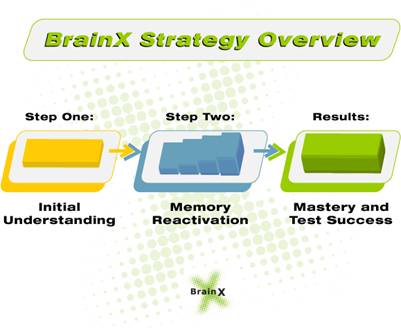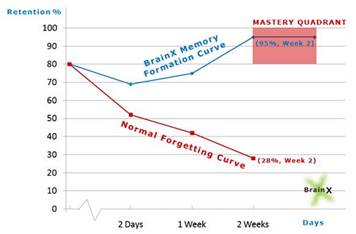BrainX Research
To understand how the learning strategies used in the BrainX system work, it is important to understand the neuroscience research on how learning happens in your brain. In this case when we use the word learning we are referring to a mastery level of learning. Sales training is a perfect example of mastery level learning in the brain. When a sales person masters both product knowledge and selling skills, their brain is able to integrate the two in real time when a prospect asks a question. This means that their brain is able to correctly recall the right product information, mentally evaluate the proper selling strategy to employ, and effectively integrate this information to deliver a verbal response that is both accurate and effective.
In the brain, mastery is achieved in a two-step process. Let's see how each step works.
Think back to your first attempts at riding a bicycle.
An experienced bicycle rider gives you instructions on holding the handle bars, pedaling and steering. You think—“Not too difficult! It doesn’t look that hard!” The interesting thing is that even though you understand the instructions, you probably aren’t able to jump on a bike and ride unassisted the first or second time you tried. Understanding the instructions is not enough.
Now fast forward a week or two. You’ve had several practice sessions and you might be proudly wearing a few band aids on your elbows. But gradually your practice is steadier—you’ve even mastered “stopping.” An amazing thing happens—like magic, you’re riding on your own.
What happened?
After enough practice your brain reaches a point where it decides this is an important skill. Your brain responds by writing instructions for itself—instructions much like a computer software program.
Now, as you mount the bicycle, the brain’s bicycle riding program instantly starts asking for information and giving directions. For example, it tells your inner ear to help you adjust your weight on the bike to maintain proper balance. Next, the program asks your eyes for information to use to help adjust the pressure that your arms and hands exert on the handle bars in order to steer around obstacles.
While all this is happening, what you know about speed, cars, obstacles, and how fast you want to go is running through the “program” to change commands to hundreds of muscles in your legs and feet. In turn, this determines how fast you peddle or if your muscles should be preparing to brake and so forth. The process is amazing. Mastery learning is not limited to things you learn as a child. Anything you want to be able to do well must be learned to the point of mastery.
What are the two steps to mastery level learning?
Our brains learn in two steps or phases. The first step is "initial understanding"; this is receiving the instruction in a way that we understand it. The second step is called "memory reactivation". Reactivation requires a series of practices—BrainX calls these study sessions. During study sessions, you use the information on different days with nights of sleep in between.
Your sessions are scheduled in a way that helps your brain give you the best results. That’s the scheduling strategy we discussed earlier.

Understanding information is the first step. A variety of methods will be used to help with understanding. Sometimes the BrainX courses give you material to read; other times you’ll watch a video. The system also uses experiential learning objects like simulations. In some courses the lessons will be available in multiple languages.
Step Two, memory reactivation, involves solving a problem. For the two-step process to be successful you need to address the problem of forgetting.

Recall and forgetting in two groups of learners.
In the chart above, two groups of learners are represented by the red and blue lines. The chart demonstrates what happens over a period of two weeks following a lesson.
At Day One, both groups receive the same instruction and understand the material to the same degree. When tested immediately after the lesson, on average, learners in both groups can remember 80% of the instruction.
After two days, the first group of learners (the red line) is tested again and is only able to recall 52% of the information. After one week, only 42% is retained. After two weeks, recall has gone from 80% to 28%. In effect, the red line illustrates a dramatic forgetting curve for this group of learners.
The second group (represented by the blue line) has a much different outcome. Two weeks after the instruction they are able to recall 95% of the instruction. This is an even higher recall rate than they had at the end of the lesson.
The reason the second group has much better results than the first group is that they used the BrainX Study Session system to reactivate their memories of the lecture on three different days—Day 2, Day 7 and Day 14 following the initial instruction. The study sessions achieve two things. First, they solve the problem of forgetting. Second, they prompt the brain to write new programming so the learners can effectively recall and use the information.
What are the three keys to effective memory reactivation?
The miraculous way the brain is able to write sophisticated programming is something that neuroscience cannot fully explain. We do know, however, what triggers the brain to write the programming.The trigger is Memory Reactivation.
These are the three keys to reactivation:
1) Practice should happen on different days because the process requires sleep between practice sessions.
2) As a learner gets closer to mastery, there should be more days between study sessions.
3) Reactivation must be active—learners must be doing something with the information; for example, writing answers to questions, actively recalling and using the information in a simulation, etc. Research has shown that passive practice, like re-listening to a lesson or re-reading a product manual, is not as effective as active practice.
Why is it so important to personalize training schedules?
Research shows that the most effective methods for stimulating memory reactivation are answering questions and participating in active simulations where the learner has to recall and use information in a real world context. For maximum effectiveness, the reactivation schedule must be personalized to each learner. For example, when a company rolls out new products the instruction for the initial understanding step can be delivered to everyone at the same time. However, the exact day that each reactivation session is scheduled must be different for every learner.
This schedule is a function of how difficult it was for the learner to gain initial understanding and the learner's natural forgetting curve. In addition, which parts of the instruction are reactivated in each study session must also be personalized to each learner. BrainX uses a patented system and proprietary algorithms to figure the ideal memory reactivation schedule for each learner and what should be reactivated in each study session or simulation.

